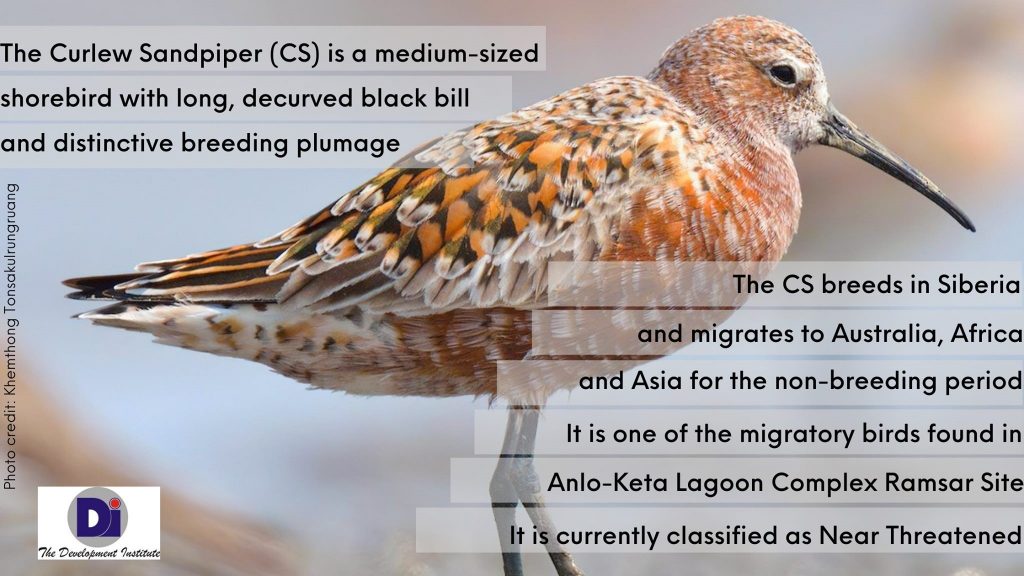
CONSERVING AND PROTECTING HABITATS OF MIGRATORY BIRDS IN THE VOLTA DELTA USING THE COMMUNITY RESOURCE MANAGEMENT AREAS (CREMA) MECHANISM.
THE ISSUE AND ITS CONTEXT.
In accordance with national legislation (L1 16-59, 1999 on wetlands), the Anlo-Keta Lagoon Complex Ramsar site (AKLCRS) was identified on August 14, 1992 and was gazetted on August 19, 1999 in compliance with the Ramsar convention.
The communities of the AKLCRS own the lands and the protection of habitats and species is advised by government acting through Wildlife Division of the Forestry Commission.
Co-management is expected, but the Ramsar management framework is unable to perform as intended due to issues including unsustainable use, the use of illegal fishing gear and poaching of migratory species like sea turtles and birds. The Ramsar site management Committees are a prime example; they are crowded with government employees, yet they face the possibility of frequent moves. As a result, communities feel disenfranchised from their rights to self-governance and resource management which makes it challenging for them to catch up with institutional memory.
A further issue is that there is not enough wildlife staff to assist with the resource management of the vast AKLCRS.
The planned CREMA mechanism aims to provide local people greater control over the governance and management of resources, promoting community stewardship with the Wildlife Division will providing technical support through the use of smaller but more capable staff.
THE COLLABORATION BETWEEN THE DEVELOPMENT INSTITUTE AND THE WILDLIFE DIVISION.
The Wildlife Division and The Development Institute collaborated to design a focused policy in 2016 on CREMA development for AKLCRS. Since then, The Development Institute has been working with the communities to implement the CREMA mechanism.
Avu Lagoon CREMA for West African Sitatunga and Angwa Lagoon CREMA for sea turtles and manatees are the two major species-specific CREMAs that have been established thus far. However, there isn’t any dedicated site for birds, particularly migratory species, even though KLCRS is among the regions on the West African coast that receives the most annual influx of migration birds.
Rationale for CREMA for avian species.
The argument for the designation of a CREMA for birds in the AKLCRS, particularly migratory birds, is that it is the most significant wetland for waterbirds on Ghana’s coast and together with Songor on the Volta River’s western portion, it is where the meridian and Atlantic flyways converge.
Approximately, 76 species of waterbirds known to call it home, with maximum populations believed to be well over 100,000 birds. Along with several heron, pelican and egret species, other species that can be found in considerable quantities are Dendrocygna viduata, Himantopus himantopus, Calidris ferruginea and C. minuta.
TARGET
This project is to designate a CREMA for the Afiadenyigba and its environ, which includes the following target communities: Anyako, Havedzi, Seva and Afiadenyigba.
The overall objective of the project is to promote community-led governance in conservation of migratory birds in the Anlo-Keta Lagoon Complex Ramsar Site (AKLCRS) using the Community Resource Management Areas (CREMA) Mechanism.
SPECIFIC OBJECTIVES.
- To set up a functional community steward system for conservation, governance and management of natural resources focusing on bird protection.
- To promote environment friendly livelihood options and practical value chain supported with community financial re-engineering as incentive for both livelihoods and conservation.
- To document and share lessons learned within and without.
PROPOSED PROJECT ACTIONS.
- Project Communications: Developing informational, communicative, and instructional resources; coordinating project goals; enlisting community and stakeholder support and pursuing community buy-in.
- Setting the baseline: Consolidation and validation of ethno-biology, ecosystem and livelihood studies.
- Engaging in the CREMA development process: This involves mobilization, consultations, election of leaders for the CRMCs and CREMA Executive Committee, constitution drafting, bylaws promulgation, development of CREMA management plan, publication in a gazette and ultimately, devolution of the site to the communities.
- Sustainable livelihood options and community finance: Setting up community sustainable livelihood and the interconnected financial system.
- Documentation and sharing of lessons learned for upscaling within the project area and beyond.
PROPOSED PRINCIPAL ACTIONS.
- To kick off the project, plan a one-day community public gathering event with 150 participants, create information, education and communication materials on birds and other biodiversity conservation as well as the CREMA mechanism.
- Validate the ethno-biological and socio-economic documentations during a 21-day period, including a field visit by using stakeholder participatory planning processes to identify possible economic activities for value chain growth.
- Visit the Municipal Assembly on a preliminary basis to meet with the presiding members, the DCEs and the pertinent legal offices in order to submit the bylaws and constitution for gazetting.
EXPECTED RESULTS
- A functional CREMA for both resident and migratory birds.
- Sustainable economic and livelihood development for participating communities, benefitting 40 people directly and 200 indirectly.
- Lessons, knowledge and skills shared annually among stakeholders, enabling increase project sustainability, upscaling in Ghana and replication by a CSO in one country in West Africa.
ANTICIPATED LONGETIVITY OF THE PROJECTS’S OUTPUT
In order to ensure sustainable development, the central government delegated management of natural resources to local communities through the CREMA mechanism, which is being used in this project. These communities are responsible for conservation and restoration, as well as for safeguarding biodiversity and their operations.
Increased governance and management abilities for CECs, CRMCs, and other community group leaders will strengthen their capacity to participate in and enhance socio-cultural life, which will contribute to environmental and economic development. By allowing community ownership and local government involvement through gazetted constitutions and bye-laws, all of these will guarantee sustainability and act as a model for future scalability.
DURATION OF THE PROJECT 12